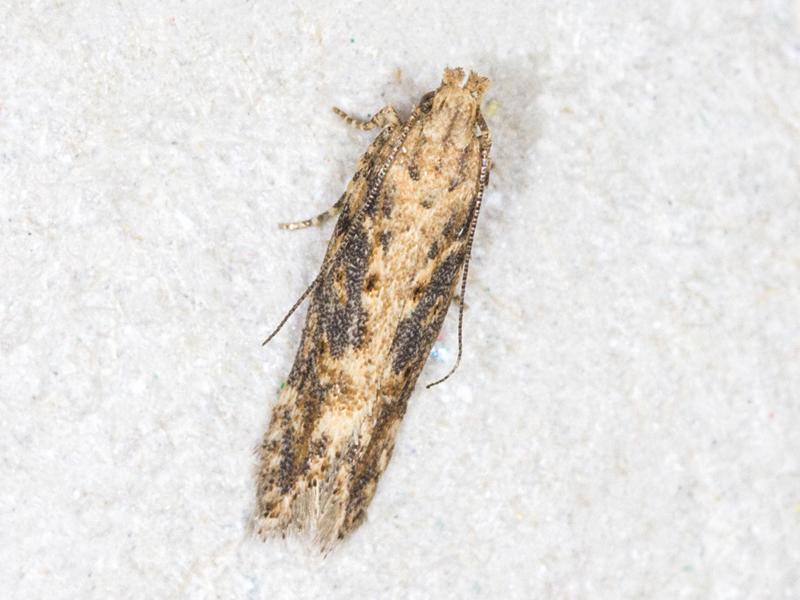Beet Moth Scrobipalpa ocellatella
New to Norfolk in 2019 but followed by four records in each of 2020 and 2021. My May record below appears to be the first spring record, but 2022 proved to be a phenomenal year for this species with huge numbers suddenly appearing. I ended up catching them on many nights, sometimes in large numbers (up to 209) and a couple of times comprising over half of the moths in the trap. At the time these started appearing, most references gave Sea Beet as the larval foodplant but noted that in Europe it has been reported as a pest species on cultivated forms of Beet and other plants. Apparently these other plants include beetroot and chard. Although several other recorders caught similarly large numbers, others recorded relatively modest numbers.
Probably the most similar species, at least to darker forms of Beet Moth, is Mottled Orache Moth Scrobipalpa atriplicella. Bittersweet Moth Scrobipalpa costella isn't listed as a similar species to ocellatella, but given the extensive dark area along the edge of the wings I think it can present a real confusion risk. Indeed I nearly passed my first Beet Moth off as such, but hesitated as it looked much less like one in my photo than it did in life. The appearance (and likeness to costella) varies according to angle and light - well lit and from the side it looks more like a dark Purslane Moth Scrobipalpa instabilella. One character that appears to help eliminate costella is the presence of a dark spot near the base of the wings, narrowly separated from the larger costella-like dark side-patch. There is probably more dark towards the apex too, but costella is quite variable in extent of dark markings.
At the start of 2022 this species was categorised as Grade 4, i.e. requiring examination of genitalia to confirm identification, but when it became clear how abundant it had become this was downgraded to Grade 3 (requiring photo evidence) except at the coast (where other similar Scropipalpa are likely). Unlike some Scrobipalpa species, the corpus bursae widens gradually from the ductus, and importantly segment 8 has a dense honeycomb pattern visible at high magnification. This is very dense close to the ostium (on the "ventral zone", i.e. centrally) but is also present on the sides (the "ventrolateral zone")
, North Elmham, 17-May-22 (A) (1).jpg)
, North Elmham, 17-May-22 (A) (2).jpg)
, North Elmham, 17-May-22 (A) (6).jpg)
, North Elmham, 17-May-22 (A) (8).jpg)
, North Elmham, 17-May-22 (A) (9).jpg)
, North Elmham, 17-May-22 (A) (7).jpg)
female Beet Moth Scrobipalpa ocellatella showing genitalia including close ups of segment 8 (focussed on ventral zone and on ventrolateral zones) and signum, North Elmham (Norfolk, UK), 17th May 2022
I recently came across a photo of my only record of Mottled Orache Moth Scrobipalpa atriplicella and for a moment thought I must have made a mistake and overlooked what would have been Norfolk's first Beet Moth. That would have been understandable given that at the time (May 2019) I believed Beet Moth was a coastal species restricted to the far south of Britain, and given that their female genitalia are very similar, but having looked carefully at my photos of the genitalia I think I was correct. Unfortunately they don't show the corpus bursae which I assume widened abruptly from the ductus bursae, which isn't the case on ocellatella. The key in MOGBI relies on this but it seems that the two species also show differences in the shape and pattern on segment 8. The proximal end of segment 8 is flatter and so more angled on ocellatella, and the intensity of honeycomb marking is greatest just in from this edge. On atriplicella the inner edge is smoother and the markings are concentrated most strongly along the edge. Also the lobes inside of the edges (I think these are the proximal end of what MOGBI refers to as the ventral zone) are a different shape - more rounded on ocellatella as shown below.
, North Elmham, 1-Aug-22 (A) (1).jpg)
, North Elmham, 1-Aug-22 (A) (2).jpg)
, North Elmham, 1-Aug-22 (A) (3).jpg)
female Beet Moth Scrobipalpa ocellatella showing genitalia including close ups of segment 8, North Elmham (Norfolk, UK), 17th May 2022
It seems I still need to photograph male ocellatella genitalia - one for another year if we don't get any more this year. In the meantime here are some that weren't dissected:
 (1).jpg)
 (2).jpg)
Beet Moth Scrobipalpa ocellatella, North Elmham (Norfolk, UK), 24th July 2022
 (3).jpg)
 (2).jpg)
 (1).jpg)
Beet Moth Scrobipalpa ocellatella, North Elmham (Norfolk, UK), 25th July 2022
.jpg)
.jpg)
.jpg)
3x Beet Moths Scrobipalpa ocellatella, North Elmham (Norfolk, UK), 14th August 2022
.jpg)
.jpg)
2x Beet Moths Scrobipalpa ocellatella, North Elmham (Norfolk, UK), 15th August 2022
.jpg)
.jpg)
.jpg)
.jpg)
4x Beet Moths Scrobipalpa ocellatella, North Elmham (Norfolk, UK), 18th August 2022

Beet Moth Scrobipalpa ocellatella, North Elmham (Norfolk, UK), 20th August 2022

Beet Moth Scrobipalpa ocellatella, North Elmham (Norfolk, UK), 21st August 2022
.jpg)
.jpg)
2x Beet Moths Scrobipalpa ocellatella, North Elmham (Norfolk, UK), 23rd August 2022
